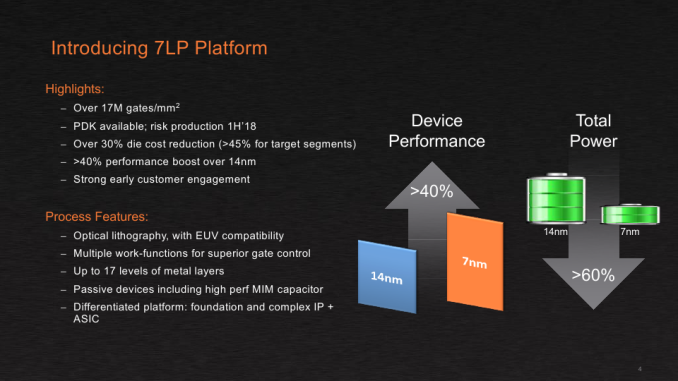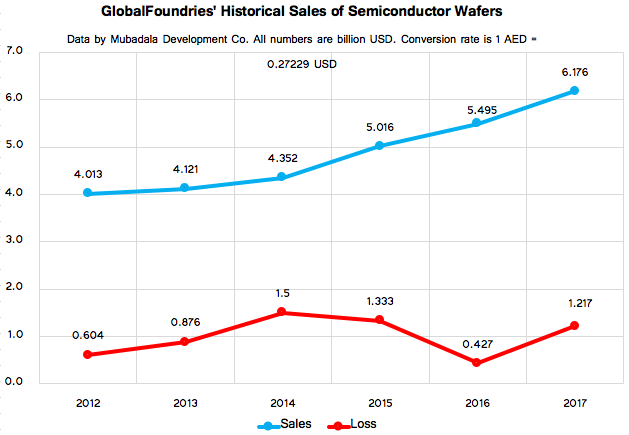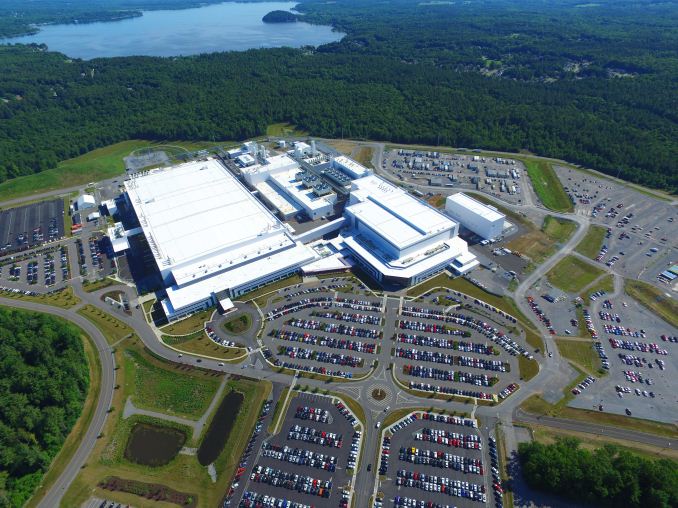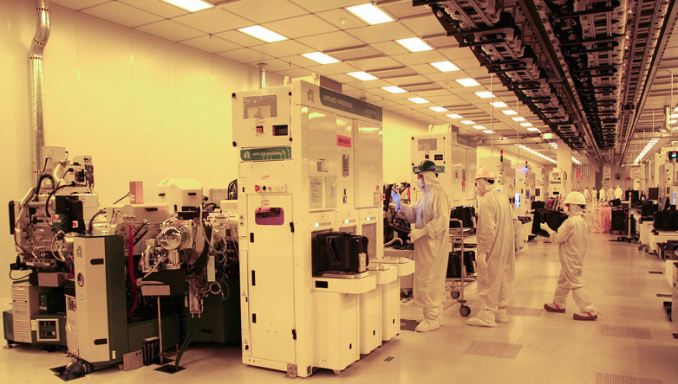
Original Link: https://www.anandtech.com/show/13277/globalfoundries-stops-all-7nm-development
GlobalFoundries Stops All 7nm Development: Opts To Focus on Specialized Processes
by Anton Shilov & Ian Cutress on August 27, 2018 4:01 PM EST- Posted in
- CPUs
- AMD
- GlobalFoundries
- Semiconductors
- 7nm
- 7LP
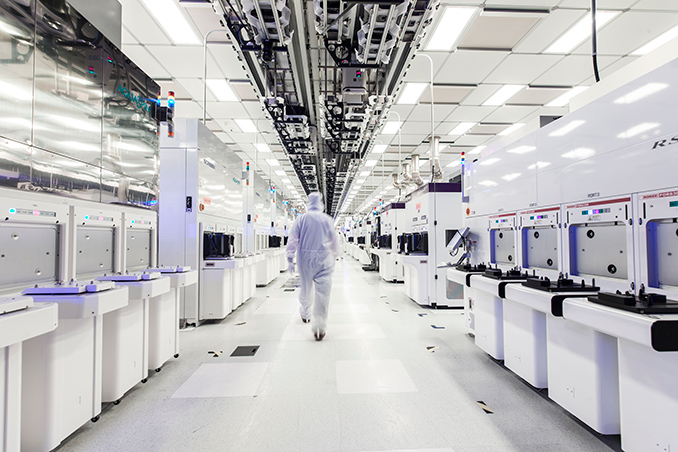
GlobalFoundries on Monday announced an important strategy shift. The contract maker of semiconductors decided to cease development of bleeding edge manufacturing technologies and stop all work on its 7LP (7 nm) fabrication processes, which will not be used for any client. Instead, the company will focus on specialized process technologies for clients in emerging high-growth markets. These technologies will initially be based on the company’s 14LPP/12LP platform and will include RF, embedded memory, and low power features. Because of the strategy shift, GF will cut 5% of its staff as well as renegotiate its WSA and IP-related deals with AMD and IBM. In a bid to understand more what is going on, we sat down with Gary Patton, CTO of GlobalFoundries.
7LP Canned Due to Strategy Shift
GlobalFoundries was on track to tape out its clients’ first chips made using its 7 nm process technology in the fourth quarter of this year, but “a few weeks ago” the company decided to take a drastic, strategic turn, says Gary Patton. The CTO stressed that the decision was made not based on technical issues that the company faced, but on a careful consideration of business opportunities the company had with its 7LP platform as well as financial concerns.
It is noteworthy that when GlobalFoundries first announced its 7LP platform in September 2016, it said that it would start risk production of processors using this technology in early 2018 (PR), which means that the first chips should have been taped out before that. When the company detailed the process in June 2018, it said that it expected to start “volume production ramping in the second half of 2018” (PR), which would be close to impossible if customers taped out their first chips only in Q4.
Generally, it looks like the company had to adjust its roadmap somewhere along the way, moving the start of high-volume manufacturing (HVM) further into 2019. Whether or not these adjustments had any implications on GlobalFoundries is up to debate. Keep in mind that AMD’s first 7 nm product was designed for TSMC’s CLN7FF from the beginning, so the company did not bet on GF’s 7LP in late 2018 anyway, and no rush with the manufacturing technology was needed for GF’s key customer.
Along with the cancellation of the 7LP, GlobalFoundries essentially canned all pathfinding and research operations for 5 nm and 3 nm nodes. The company will continue to work with the IBM Research Alliance (in Albany, NY) until the end of this year, but GlobalFoundries is not sure it makes sense to invest in R&D for ‘bleeding edge’ nodes given that it does not plan to use them any time soon. The manufacturer will continue to cooperate with IMEC, which works on a broader set of technologies that will be useful for GF’s upcoming specialized fabrication processes, but obviously it will refocus its priorities there as well (more on GF’s future process technologies later in this article).
So, the key takeaway here is that while the 7LP platform was a bit behind TSMC’s CLN7FF when it comes to HVM – and GlobalFoundries has never been first to market with leading edge bulk manufacturing technologies anyway – there were no issues with the fabrication process itself. Rather there were deeper economic reasons behind the decision.
Economic Reasons Behind the Move
As we noted in our article covering GlobalFoundries's new CEO hire earlier this year, former CEO Sanjay Jha was never able to make the company profitable. His key tasks were to increase GlobalFoundries’s sales, streamline the company in general, and ensure that it executes its roadmap.
To address the needs of the manufacturer’s traditional key client (AMD) and ensure that his company was competitive against other contract makers of semiconductors, he licensed Samsung Foundry's 14LPP fabrication technology. That strategy worked well. With Sunjay Jha at the helm, GlobalFoundries has managed to land a variety of new customers and increase its sales of semiconductor wafers from approximately $4.121 billion in 2013 to $6.176 billion in 2017. Besides, the foundry’s leading-edge Fab 8, which has been processing wafers using exclusively 14LPP process technology for well over 1.5 years now, is running at full capacity.
To ensure that GlobalFoundries remains competitive against Samsung Foundry and TSMC in the long run, Sunjay Jha obtained IP and development teams from IBM (along with two fabs and a lot of obligations), and poured in billions of dollars in development of the 7LP fabrication technology platform. The latter would include three generations of manufacturing processes and, possibly, a custom high-performance technology available exclusively to IBM. While everything appeared to proceed smoothly with the 1st Gen 7 nm process (DUV only), the 2nd Gen 7 nm process (with EUV used for non-critical layers, such as padding) still needed some additional development investments, and the 3rd Gen 7 nm (with intensive usage of EUV) required even more money for development and further could require installation of additional EUV equipment. Meanwhile, there were two things to consider.
First. If GlobalFoundries kicks off production using the 1st Gen 7 nm fabrication process, it would have needed to cure all of its teething troubles and offer its clients a roadmap forward. The latter would have included 2nd Gen and 3rd Gen 7 nm, but nothing stops there. Customers would have asked for 5 nm and then for 3 nm nodes. Meanwhile, you cannot tell your clients that you are packing up after a certain node and then hope that this node will be a success (the same is true for DUV-only 1st Gen 7 nm).
Second. Development of leading-edge process technologies is extremely expensive. Every new node requires billions of dollars in investments. Those costs are eventually amortized over each chip the company makes, so to keep increasing R&D costs from driving up chip prices, foundries need to produce more chips. To make more chips, they need to either run multiple fabs that use the same process technology (these are going to cost $10+ billion in the EUV era), or build giant fabs that process a gargantuan number of wafers (these are going to cost $20+ billion in the EUV era). Meanwhile, GlobalFoundries has only one leading-edge fab featuring capacity of 60,000 wafer starts per month. As a result, either GlobalFoundries has to pass these R&D costs on to the finite number of wafers it processes – and become uncompetitive against rivals in the process – or eat the costs with reduced profitability.
Meanwhile, having spent well over $20 billion on GlobalFoundries over the last 10 years, Mubadala, the owner of the company, is not inclined to lose more money or invest tens of billions in the hopes of becoming profitable one day. The investor wants GlobalFoundries to stop bleeding and start generating profits.
“The culture of [our investments], the ones I’ve been involved with, was about accumulating assets and then just maintaining it,” said Mubadala CEO Khaldoon Al Mubarak in an interview with Bloomberg earlier this year. “The shift that has happened over the last couple of years, that I’ve tried to push at Mubadala today, is a monetization strategy that makes sense, not with a view to cash out but with a view to reinvest.”
Gary Patton admits that GlobalFoundries never planned to be a leading producer of 7-nm chips in terms of volume. Furthermore, the company has been seeing increasing adoption of its 14LPP/12LP technologies by designers of various emerging devices, keeping Fab 8 busy and leaving fewer step-and-scan systems for 7LP products.
Without another big fab, it would be impossible to make any new leading-edge process technology competitive against Samsung and TSMC due to aforementioned scale reasons. Meanwhile, building a new fab (or even expanding the Fab 8 with another clean room module, which is something that GF considered several years ago) and creating another node or two would require another $10 – $15 billion from Mubadala, which is not inclined to invest just now. As a result, the GlobalFoundries has decided to switch entirely to specialized process technologies for emerging high-growth markets. This strategic shift enables it to reduce spending on R&D, slowdown procurement of new equipment, reduce its workforce by 5% (most of which will be in Malta), and potentially avoid direct competition against the aforementioned contract makers of semiconductors.
What’s Next for GlobalFoundries?
In lieu of pursuing a 7nm platform, GlobalFoundries will be embarking on a multifaceted strategy for revenue and profitability. This strategy includes scaling out the 14LPP/12LP platform for various applications that are set to emerge in the 5G era, continuing to evolve the FD-SOI platform, spinning off its ASIC development business, further supporting its existing clients with their 14LPP/12LP products, and some other things.
Scaling Out the 14LPP/12LP
Originally designed for mobile SoCs and some other chips in mind, GlobalFoundries' 14LPP manufacturing technology is used to make CPUs and GPUs at GlobalFoundries. Furthermore, the company has designed two variations of this fabrication process. Whereas the base process used up to 13 metal layers and 9T libraries, 14HP was developed specifically for IBM and tailored for performance at the cost of transistor density, using up to 17 metal layers and 12T libraries. Meanwhile, 12LP — aimed at a broad spectrum of applications, including APUs/CPUs, automotive and other — uses 13 layers and 7.5T libraries, giving a 10% additional performance or power improvement as well as a 15% area reduction vs. the 14LPP.
Going forward, GlobalFoundries plans to offer a broader spectrum of technologies based on its 14 nm node. The move is not truly surprising. Samsung Foundry also offers three versions of its 14 nm processes: 14LPP for high-performance SoCs, 14LPC for compact SoCs, and 14LPU for ultra-low-power chips. So far, GlobalFoundries has confirmed three key markets of its future FinFET process technologies: RF, embedded memory, and low-power. In addition, the company plans to offer its 14LPP/12LP platform with enhanced performance and/or higher transistor density (for cost reduction). To do so, the company will be leveraging the knowledge and techniques they developed as part of the 7LP platform. But naturally Gary Patton does not want to disclose the nature of these innovations or any actual performance targets.
If the company succeeds in the integration of RF capabilities into FinFET-based chips, that will be a world’s first. In theory, such chips would have a notable edge over existing RF solutions, which are made using rather rough process technologies. In addition to regular RF capabilities, GlobalFoundries plans to offer features for mmWave radios. Embedded MRAM will also be another important feature of SoCs made using a FinFET fabrication tech as, again, nobody uses such transistors for embedded memory right now.
At the moment, GlobalFoundries is still forming its new development teams, so we do not know exactly how many projects the company will eventually work on. Meanwhile, keep in mind that any project started today will materialize at best in 2020, with actual products going into HVM in 2021. This will be in time for various devices for high-growth markets, but AMD will naturally wind down its 14LPP/12LP orders to GlobalFoundries over the 2019 – 2020 timeframe, reducing the company’s revenue and profits. Note that at present both the RF and embedded memory technologies for FinFET are in a pathfinding stage, so it is very hard to say when exactly GlobalFoundries comes up with appropriate process technologies.
Investing in FD-SOI
In addition to developing specialized versions of its FinFET-based process technologies, GlobalFoundries will continue to invest in its FDX-branded FD SOI-based platforms, such as 22FDX and 12FDX. Gary Patton did not pre-announce any new versions of the company’s FD-SOI fabrication processes, but clearly indicated that the FDX will remain very important for GlobalFoundries, which is not surprising as GF and Samsung Foundry are the only foundries to offer this tech.
Spinning Off ASICs
Designing chips for a new process technology is always a challenge both from engineering and financial points of view, especially for smaller companies. In a bid to help its customers to develop various SoCs, GlobalFoundries established its ASIC Solutions (ASICs) division, which helps the company’s customers in designing chips. Besides usual things like process development kits (PDKs), various design libraries, silicon-proven memory solutions, interfaces, and other necessary things, ASICs offers support from chip design, methodology, test and packaging teams.
Obviously, GlobalFoundries’ customers going forward will benefit from ASICs IP and teams. However, to ensure that the division continues to attract high-volume work, GlobalFoundries will spin it off and enable it to work with process technologies from other contract makers of semiconductors.
The Fate of EUV Tools
One of the questions we asked GlobalFoundries during a briefing concerning its strategic shift was about the fate of two ASML Twinscan NXE machines installed in Fab 8. At this point the company has not made any decisions, but it intends to consult with ASML and find out what would be the best use of these tools. In theory, GlobalFoundries could keep them to speed up prototyping or even production, but since they require a special treatment, keeping them without using them extensively for HVM may not be a good idea.
Some Thoughts
Until today, GlobalFoundries, Samsung Foundry, and TSMC were the only three remaining contract makers of semiconductors to offer leading-edge process technologies for logic. With GF dropping out from the race, Samsung and TSMC will be the only contract foundries remaining. (While Intel technically has foundry operations, they've had minimal impact on the industry).
For GlobalFoundries, the move has pros and cons. On the one hand the lion’s share of semiconductor industry revenue will be earned from chips made using ’12 nm’ and larger nodes even in 2022, according to Gartner’s findings and cited by GlobalFoundries. Evidently, by not competing for the leading edge, GF will reduce its R&D costs and necessity to build ultra-expensive EUV fabs for 2020 and onwards. Moreover, with specialized technologies sometimes tailored for particular clients, the company will better avoid directly competing against Samsung and TSMC in certain cases. Nonetheless, said foundries are going to compete for emerging devices as well, so they are going to design their own specialized fabrication processes (Samsung in particular will need them for itself). Therefore, GlobalFoundries is not exactly jumping into a blue ocean here.
What remains to be seen is how well GlobalFoundries manages to execute on the timely development of multiple new manufacturing processes and land new customers to fill Fab 8. The company will keep working with AMD for many years to come in fabbing current-generation CPUs and GPUs, and then switching exclusively to wafers with embedded APUs/GPUs as well as with first-gen EPYC dies, as these products have very long lifecycles. However, the number of wafers GlobalFoundries processes for AMD will be dropping rapidly starting from 2019. Whether GF will be able to substitute AMD’s orders with orders from enough smaller players to Fab 8 full utilized is something only time will tell.
While it is sad to see GlobalFoundries leaving the ‘bleeding edge’ field, it is evident that the company’s odds against Samsung and TSMC were not high enough for the owner and the management to take the risks. Therefore, it looks like ‘scaling out’ by offering a set of specialized (and maybe even unique) process technologies instead of ‘scaling up’ and offer another ‘bleeding edge’ node might just be a better bet for GlobalFoundries.
Related Reading:
- Change of Strategy: A New GlobalFoundries CEO in Dr. Thomas Caulfield
- The Future of Silicon: An Exclusive Interview with Dr. Gary Patton, CTO of GlobalFoundries
- GlobalFoundries Announces 22FDX Milestone: $2 Billion in Design Wins
- GlobalFoundries Gives 7 nm Capacity Update, Mulls Skipping 5 nm
- GlobalFoundries Weds FinFET and SOI in 14HP Process Tech for IBM z14 CPUs
- GlobalFoundries Adds 12LP Process for Mainstream and Automotive Chips; AMD Planning 12LP CPUs & GPUs
- GlobalFoundries Details 7 nm Plans: Three Generations, 700 mm², HVM in 2018
- GlobalFoundries to Expand Capacities, Build a Fab in China
GlobalFoundries Press Release
GlobalFoundries Reshapes Technology Portfolio to Intensify Focus on Growing Demand for Differentiated Offerings
Semiconductor manufacturer realigns leading-edge roadmap to meet client need and establishes wholly-owned subsidiary to design custom ASICs.
Santa Clara, Calif., August 27, 2018 – GLOBALFOUNDRIES today announced an important step in its transformation, continuing the trajectory launched with the appointment of Tom Caulfield as CEO earlier this year. In line with the strategic direction Caulfield has articulated, GF is reshaping its technology portfolio to intensify its focus on delivering truly differentiated offerings for clients in high-growth markets.
GF is realigning its leading-edge FinFET roadmap to serve the next wave of clients that will adopt the technology in the coming years. The company will shift development resources to make its 14/12nm FinFET platform more relevant to these clients, delivering a range of innovative IP and features including RF, embedded memory, low power and more. To support this transition, GF is putting its 7nm FinFET program on hold indefinitely and restructuring its research and development teams to support its enhanced portfolio initiatives. This will require a workforce reduction, however a significant number of top technologists will be redeployed on 14/12nm FinFET derivatives and other differentiated offerings.
“Demand for semiconductors has never been higher, and clients are asking us to play an ever-increasing role in enabling tomorrow’s technology innovations,” Caulfield said. “The vast majority of today’s fabless customers are looking to get more value out of each technology generation to leverage the substantial investments required to design into each technology node. Essentially, these nodes are transitioning to design platforms serving multiple waves of applications, giving each node greater longevity. This industry dynamic has resulted in fewer fabless clients designing into the outer limits of Moore’s Law. We are shifting our resources and focus by doubling down on our investments in differentiated technologies across our entire portfolio that are most relevant to our clients in growing market segments.”
In addition, to better leverage GF’s strong heritage and significant investments in ASIC design and IP, the company is establishing its ASIC business as a wholly-owned subsidiary, independent from the foundry business. A relevant ASIC business requires continued access to leading-edge technology. This independent ASIC entity will provide clients with access to alternative foundry options at 7nm and beyond, while allowing the ASIC business to engage with a broader set of clients, especially the growing number of systems companies that need ASIC capabilities and more manufacturing scale than GF can provide alone.
GF is intensifying investment in areas where it has clear differentiation and adds true value for clients, with an emphasis on delivering feature-rich offerings across its portfolio. This includes continued focus on its FDXTM platform, leading RF offerings (including RF SOI and high-performance SiGe), analog/mixed signal, and other technologies designed for a growing number of applications that require low power, real-time connectivity, and on-board intelligence. GF is uniquely positioned to serve this burgeoning market for “connected intelligence,” with strong demand in new areas such as autonomous driving, IoT and the global transition to 5G.

